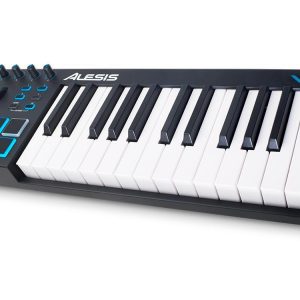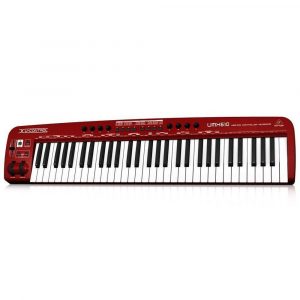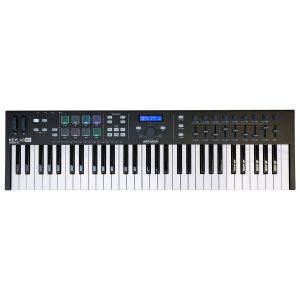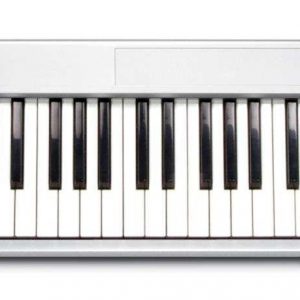M-Audio Oxygen Pro Mini
$86.99
Create music on the go with the M-Audio Oxygen Pro Mini midi keyboard, perfect for any musician or producer looking for a portable and versatile solution.
Compare
Description
The M-Audio Oxygen Pro Mini MIDI Device is a compact and portable tool tailor-made for music production on the go. It is equipped with a plethora of features that allow musicians and producers to produce high-quality music without the need for a studio or specialized equipment. In this article, we take a closer look at the features of the M-Audio Oxygen Pro Mini MIDI Device and how it can help take your music production to the next level.
Design and Build
The M-Audio Oxygen Pro Mini MIDI Device is designed for compact portability. The device measures just 0.98 inches by 16.46 inches by 4.8 inches and weighs only 1.83 pounds. This makes it an excellent choice for music producers who travel a lot. The device is made from high-quality materials, including premium synth-action keys and a robust chassis that ensures durability.
Controls and Connectivity
The M-Audio Oxygen Pro Mini MIDI Device has a vast array of controls that allow users to tweak their music production to their specifications. The device features eight touch-sensitive knobs for tweaking effects and EQ, ten assignable buttons for quick access to virtual instruments and plugins, and a directional pad that can be used for navigating between tracks.
The device also features USB bus power, so there’s no need for an external power supply. It has class-compliant USB-MIDI connectivity, ensuring it works seamlessly with any DAW software without the need for drivers. Additionally, it is compatible with both Mac and PC systems.
Integration
The M-Audio Oxygen Pro Mini MIDI Device integrates seamlessly with all major music production software. The device comes with Pro Tools First – Avid’s production software, Starter edition of Ableton Live, Eleven Lite guitar amp plug-in and a range of premium plugins that make music production a breeze. This integration enables musicians to get creative with their music and produce high-quality sounds with little effort.
Conclusion
The M-Audio Oxygen Pro Mini MIDI Device is an excellent choice for musicians and producers looking for a compact, portable, and easy-to-use device for producing high-quality music on the go. Its vast array of controls, USB-MIDI connectivity, and seamless software integration make it an invaluable tool for music production. Get your hands on the M-Audio Oxygen Pro Mini MIDI device and take your music production to the next level.
M-Audio Oxygen Pro Mini properties
| Product name |
Oxygen Pro Mini |
| Brand |
M-Audio |
| Type |
Keyboard Instruments |
| Keyboard Instrument |
MIDI Keyboard |
| Keys |
Yes |
| Number of Keys |
32 pcs |
| Key Functions |
Semi Weighted |
| Drawbars/Sliders |
Yes |
| Pads |
Yes |
| Rotary Controls |
Yes |
| Modulation Wheel |
Yes |
| Pre-Programmed Rythmes |
No |
| Pre-Programmed Songs |
No |
| Pre-Programmed Sounds |
No |
| Pre-Programmed Drumset |
No |
| Connections |
MIDI, Pedal for Keyboard Instrumet, USB |
| Colour |
Black |
| Power Supply |
Electrical Cable to Wall Socket |
Frequently Asked Questions:
What is the maximum polyphony of the M-Audio Oxygen Pro Mini?
The M-Audio Oxygen Pro Mini has a maximum polyphony of 61 notes.
How do I properly connect the M-Audio Oxygen Pro Mini MIDI keyboard to a Mac computer using USB and MIDI ports?
First, ensure that both your M-Audio Oxygen Pro Mini MIDI keyboard and your Mac computer have the necessary USB and MIDI connections. The Oxygen Pro Mini has a USB-C connector (USB 2. DIN MIDI in/out ports. Your Mac should have at least one USB port available for connecting the Oxygen Pro Mini. Connect the Oxygen Pro Mini to your Mac using a USB cable. Insert one end of the USB cable into the USB-C connector on the back of the keyboard, and insert the other end into an available USB port on your Mac. To connect the MIDI in/out ports of the Oxygen Pro Mini to your Mac, you'll need a separate MIDI interface or a compatible MIDI-enabled audio interface that supports MIDI out functionality. If you don't have such an interface available, you can skip this step and continue using USB connectivity alone. If you do have a MIDI interface, connect the MIDI in port of your interface to the MIDI in port on the back of the Oxygen Pro Mini. Connect the MIDI out port of your interface to your Mac's MIDI input (e. MIDI port or USB-MIDI port). Once connected, launch a digital audio workstation (DAW) or any other compatible software on your Mac that supports MIDI input and output. The Oxygen Pro Mini should now be recognized by the software as a MIDI device. You can use the keyboard's MIDI capabilities to control various parameters of your software, such as synthesizer patches or virtual instrument settings. You can also connect external MIDI devices (such as a drum pad or wind controller) to the Oxygen Pro Mini's MIDI out port and have them communicate with your Mac via the interface you connected earlier in step 4. If you experience any issues during setup, consult the user manual for your specific Oxygen Pro Mini model or contact M-Audio support for further assistance.
What is the recommended software compatibility for programming and editing sounds using the M-Audio Oxygen Pro Mini MIDI keyboard?
The M-Audio Oxygen Pro Mini MIDI keyboard is compatible with most major digital audio workstations (DAWs) such as Ableton Live, Logic Pro X, Cubase, FL Studio, and GarageBand. It also supports Windows and Mac operating systems with USB connectivity for programming and editing sounds. Therefore, users can easily integrate the Oxygen Pro Mini into their existing setup, whether running on a desktop or laptop computer.
How do I properly calibrate the M-Audio Oxygen Pro Mini MIDI keyboard for optimal performance when used with digital audio workstations and synthesizers?
To calibrate your M-Audio Oxygen Pro Mini MIDI keyboard for optimal performance, follow these steps:
1. Connect the keyboard to your computer via USB and turn it on. Launch your preferred Digital Audio Workstation (DAW) or synthesizer software. Go to the MIDI settings in your software. This will typically be found under MIDI preferences, options, or setup. In the MIDI settings, select "M-Audio Oxygen Pro Mini" as your input and output device for MIDI data. In the DAW or synthesizer software, create a new MIDI track or load an existing one. Select the MIDI track and ensure that it is set to receive MIDI data from your Oxygen Pro Mini keyboard. Open the MIDI mapping utility in your software (this may be called something different depending on the software). In the MIDI mapping utility, map the Oxygen Pro Mini's MIDI notes and controllers to the corresponding functions within your software or synthesizer. For example, you might want to assign certain keys on the keyboard to trigger specific sounds in your synth, or assign a slider to control a specific parameter like filter cutoff frequency. Once you have mapped everything, save your MIDI mapping settings and test your keyboard's performance with your software or synthesizer. If you notice any issues or inconsistencies in the way your keyboard is responding, you can try adjusting the calibration settings for your Oxygen Pro Mini. To do this:
a. Go to the MIDI settings in your software and select "M-Audio Oxygen Pro Mini" as your input/output device. In your DAW or synthesizer, create a new MIDI track and load a test MIDI file (you can download one from the internet if you don't have one already). Play a few notes on your keyboard and observe how they are being translated into MIDI data in your software. If you notice any discrepancies or inconsistencies, you may need to adjust the calibration settings for your Oxygen Pro Mini. To do this, go to the Oxygen Pro Mini's settings menu (this can typically be accessed by holding down a specific key combination while the keyboard is turned on) and select "Calibration". Follow the prompts to adjust the calibration settings until you achieve optimal performance. This may involve tuning the keyboard's internal oscillators or adjusting the sensitivity of various controllers. Once you have adjusted the calibration settings, test your keyboard's performance again with your software or synthesizer. Repeat this process as necessary until you are satisfied with the way your Oxygen Pro Mini is responding.
Before you buy M-Audio Oxygen Pro Mini







Reviews
There are no reviews yet.